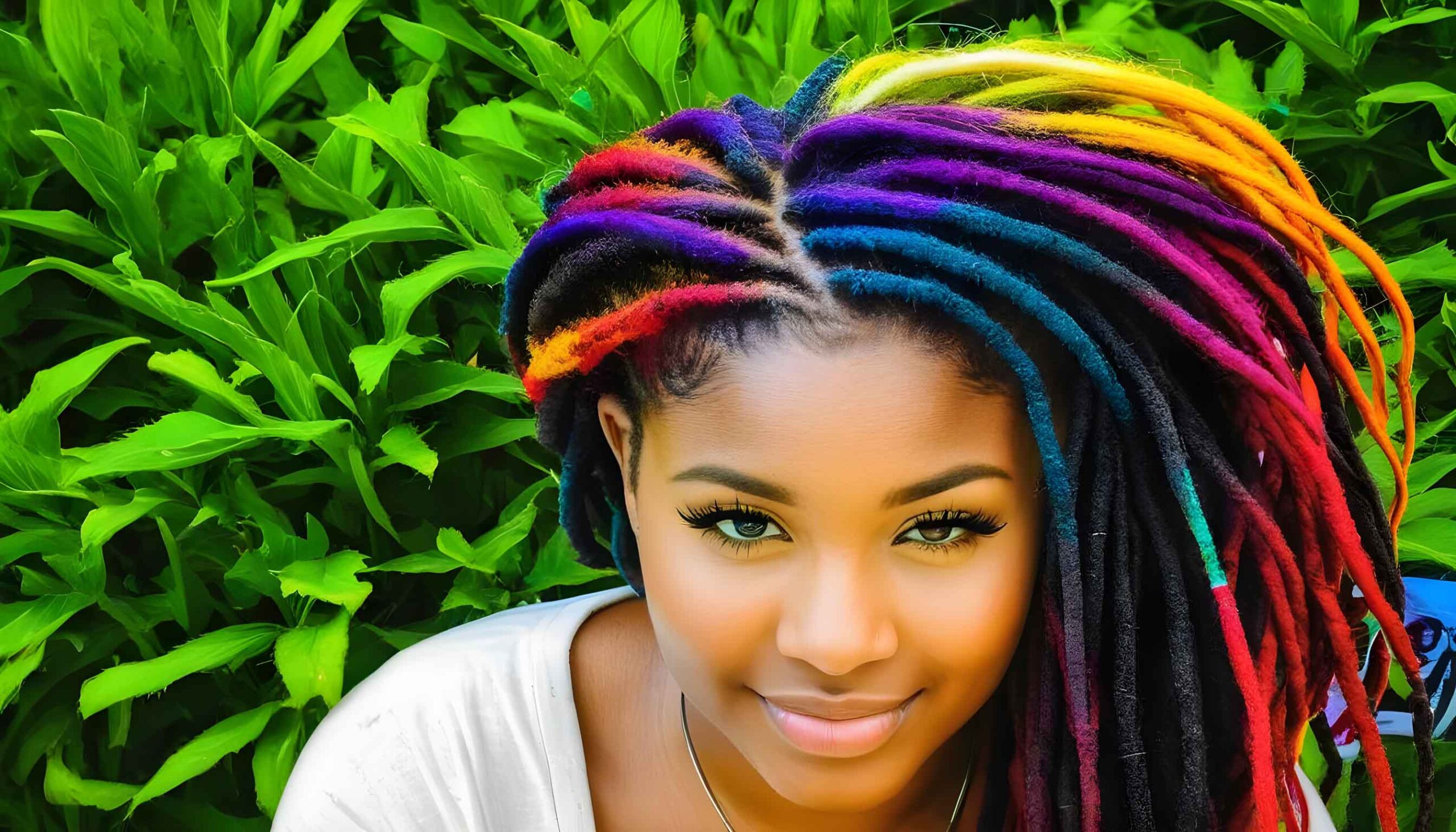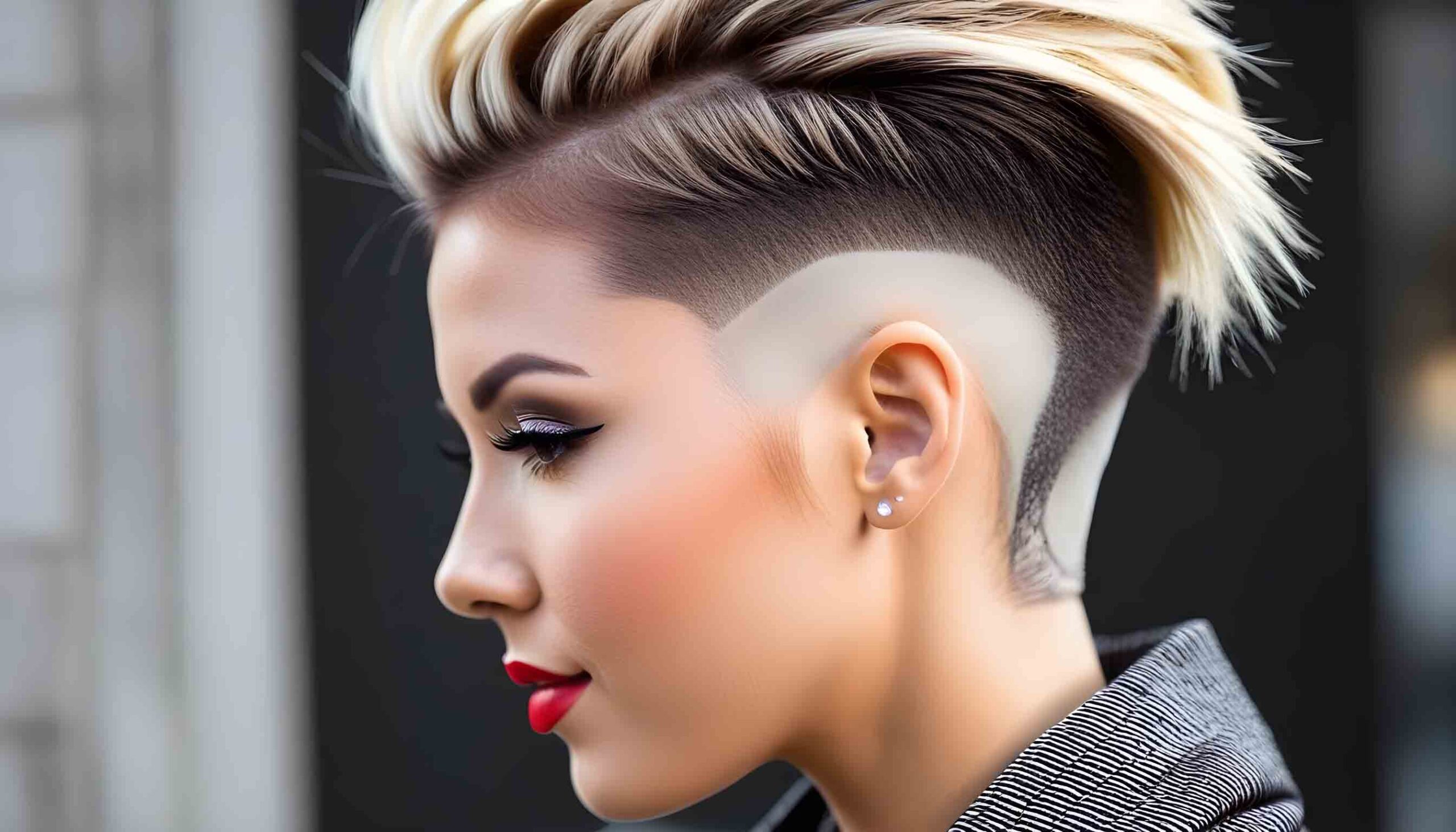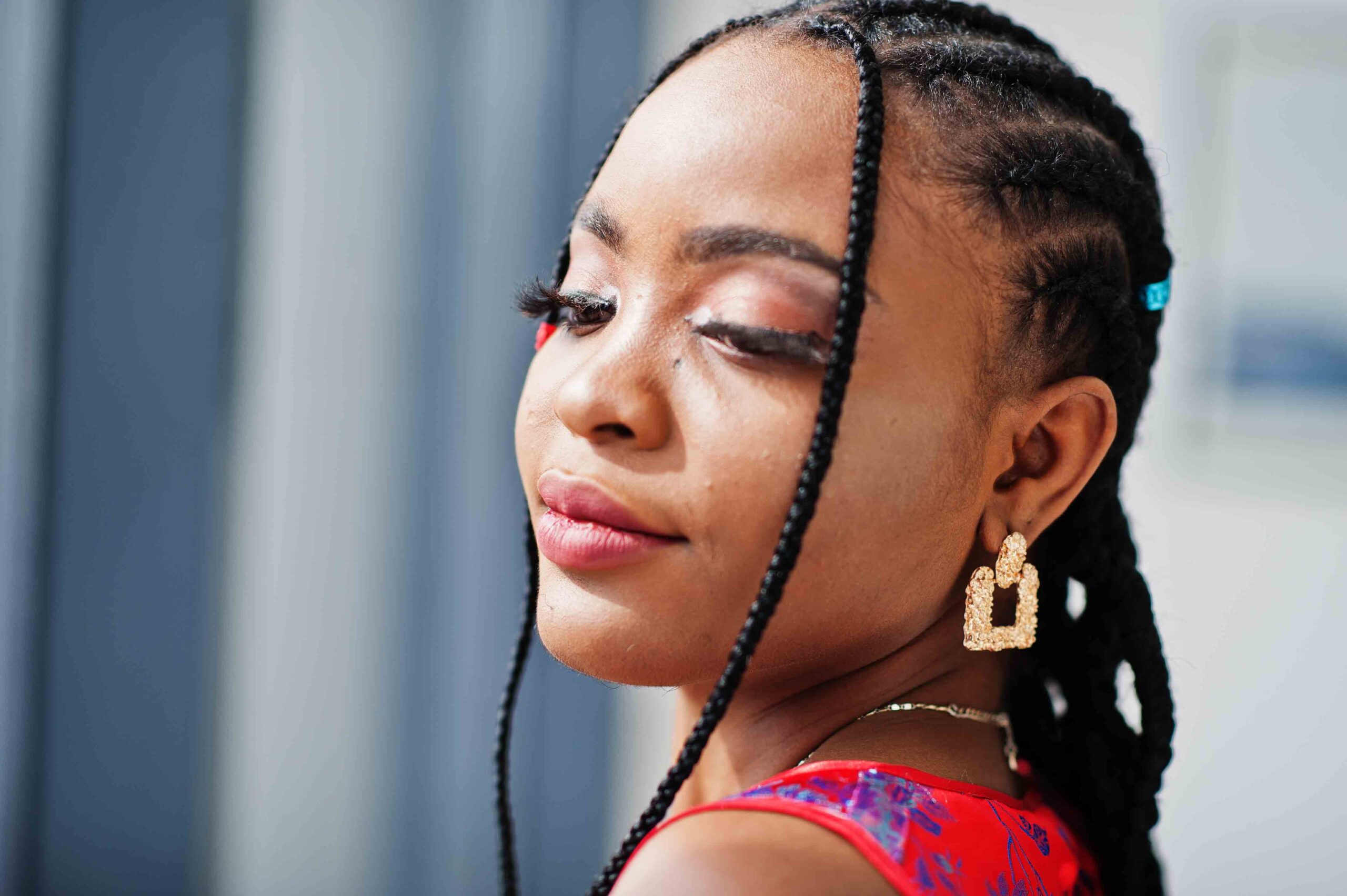Coloring dreadlocks allows you to experiment with vibrant hues while expressing your individuality. However, coloring locs require special care to avoid damage and maintain healthy hair. This comprehensive guide provides tips for dyeing locs safely while achieving stunning results.
Maintaining Healthy Locs: A Guide to Coloring Without Damage
Dreadlocks offer an edgy, artistic hairstyle that celebrates natural textures. Coloring locs can take your look to the next level, but maintaining healthy, vibrant hair requires diligent care. Follow these expert tips for dyeing your locs without causing breakage or dryness.
The Loc Dyeing Process
Dyeing locs demands a gentle approach. Most conventional hair dyes contain harsh chemicals like ammonia and peroxide that can damage delicate locs. Using professional dreadlock-safe dyes with nourishing ingredients is key.
To minimize stress on your locs, section them carefully during application. Locs should be dyed one-by-one from root to tip, fully saturating each loc shaft. Processing times may need to be reduced to avoid overprocessing. Rinse with cool water and deep condition to restore moisture.
Choosing Dreadlock-Friendly Dyes
Avoid dyes with damaging chemicals like peroxide or ammonia. Opt for semi-permanent or demi-permanent dyes designed specifically for locs and textured hair. Quality brands offer conditioning formulas that deposit rich color while keeping locs hydrated.
Explore dye options like:
- Natural, vegetable-based dyes with nourishing botanical oils
- Semi-permanent dreadlock dyes with milder developers
- Demi-permanent formula with lower peroxide levels
- Temporary dreadlock colors that lightly coat the hair
Vibrant, non-damaging dreadlock dyes allow you to refresh your color frequently without wreaking havoc on your locs. Consult a professional to select an ideal formula for your hair.
Vibrant Hues for Locs
From subtle natural tones to wildly colorful shades, locs look amazing in any hue. Consider these trending options:
- Pastels: Soften your look with dreamy pastel pink, purple, blue or peach. Avoid over-bleaching by using locs that are already light blonde.
- Rainbow: Go bold with a mix of vivid rainbow colors like red, orange, yellow, green, blue and purple.
- Ombre: Gradually transition from a dark root to light tips for a striking look.
- Two-Tone: Make a statement by dyeing the top and bottom halves of your locs in contrasting colors.
- Metallic: Add luxury with silver, gold, or copper metallic shades.
Caring for Dyed Locs
Preserve your vivid hue and keep locs healthy by:
- Moisturizing daily with oils to boost shine and prevent dryness
- Using sulfate-free shampoos and silicone-free conditioners
- Avoiding over-washing, heat tools, and friction from tight hairstyles
- Rinsing with cool water to lock in color
- Doing occasional apple cider vinegar rinses to seal cuticles
- Using color-depositing treatments to refresh color
- Getting regular trims to snip away dry ends
With the proper techniques and products, you can dye locs without compromising the health of your hair. Follow these tips to maintain vibrant, strong dreadlocks.
Different Color Dreads
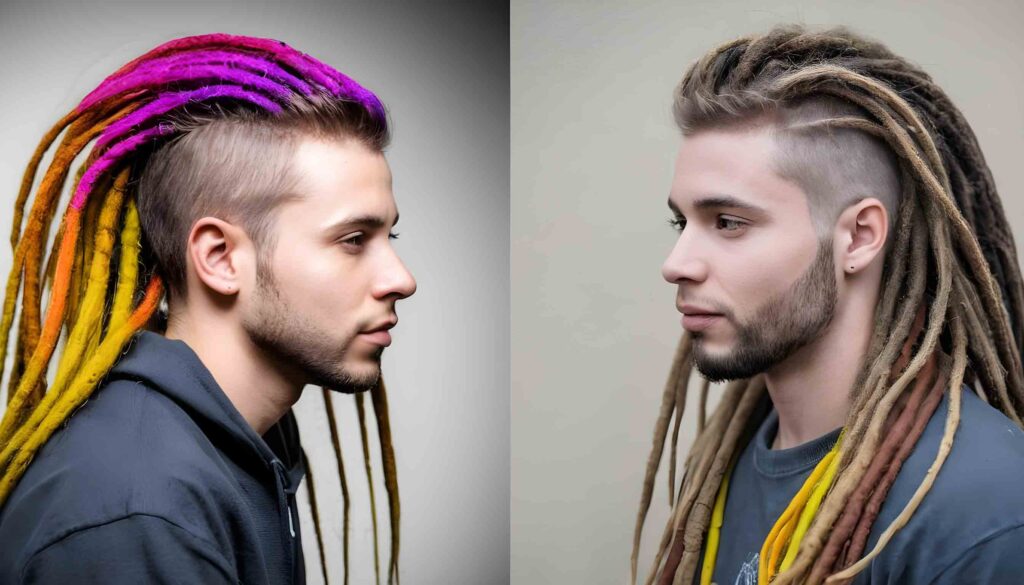
Dreadlocks serve as a unique canvas for creative hair coloring in vibrant shades. From neon hues to pastel tones, different color dreads allow you to make a bold statement. When dyeing locs, use professional hair coloring techniques and quality semi-permanent dyes to avoid damage. Prep hair properly before applying dye in neat sections for full saturation.
Follow the instructions for development time and rinse thoroughly until the water runs clear. Deep condition after coloring for hydration. Avoid frequent washing, heat styling, and friction to make the color last. Exposure to the sun can also fade hues faster. With proper coloring methods and aftercare, different color dreads let you change up your style with eye-catching and artistic effects. From subtle natural highlights to rainbow shades, embrace self-expression with the ideal locs hue.
Multi Color Dreads
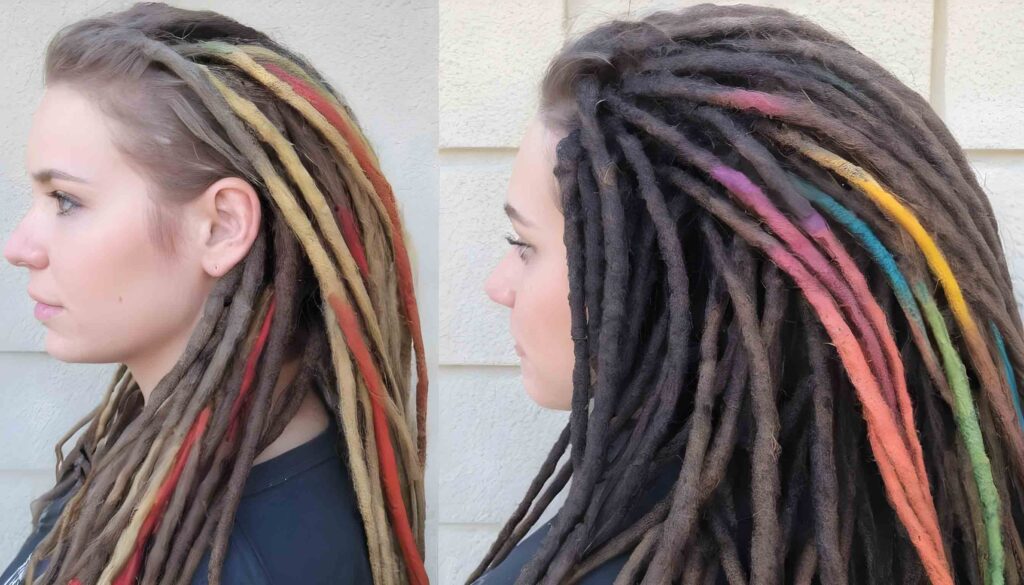
Dreadlocks offer the perfect canvas for creating a rainbow of vibrant hues. From ombre blends to all-over bright shades, multi-color dreads let you showcase your unique style. When coloring locs, choose semi-permanent dyes made for textured hair to prevent dryness and damage. Thoroughly prep hair beforehand by clarifying, detangling,
and sectioning to allow dyes to absorb evenly. Carefully apply the colors one section at a time, taking care around the edges. Allow proper processing time then rinse extremely thoroughly. Deep condition after rinsing. Maintain your vivid multi-toned dreads by moisturizing daily, washing less frequently, avoiding heat styling, and sleeping on a satin pillowcase. With strategic coloring techniques and aftercare, you can rock multi-color dreads that reflect your creative spirit.
Copper Color Dreads
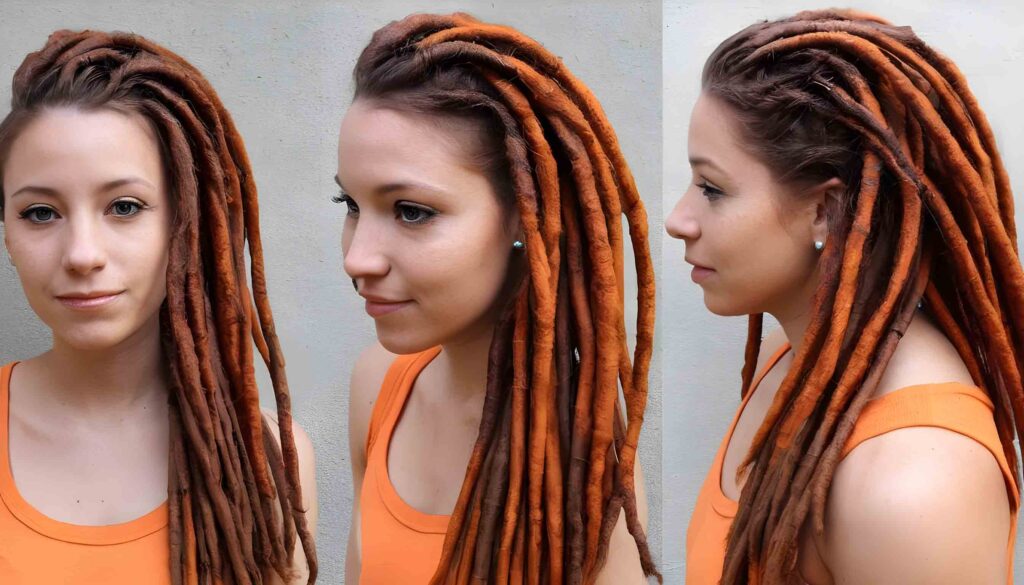
Copper is a beautiful hair color option for dreadlocks, creating a warm glow reminiscent of a shiny new penny. The multi-dimensional metallic hue ranges from light strawberry blonde to deep auburn tones. When applying a copper dye to locs, choose a semi-permanent formula designed for textured hair. Prep your dreads by cleansing thoroughly and sectioning evenly.
Saturate each loc using a tint brush, applying from root to tip. Process the dye fully, then rinse until the water runs clear. Deep condition after coloring to nourish locs. Over time, regularly moisturize and gently wash dreads to make the copper color last. Avoid chlorine, sun exposure, and heat styling. With the right coloring techniques and maintenance, copper color dreads offer a striking yet natural look that pairs well with most complexions.
Burgundy Color Dreads
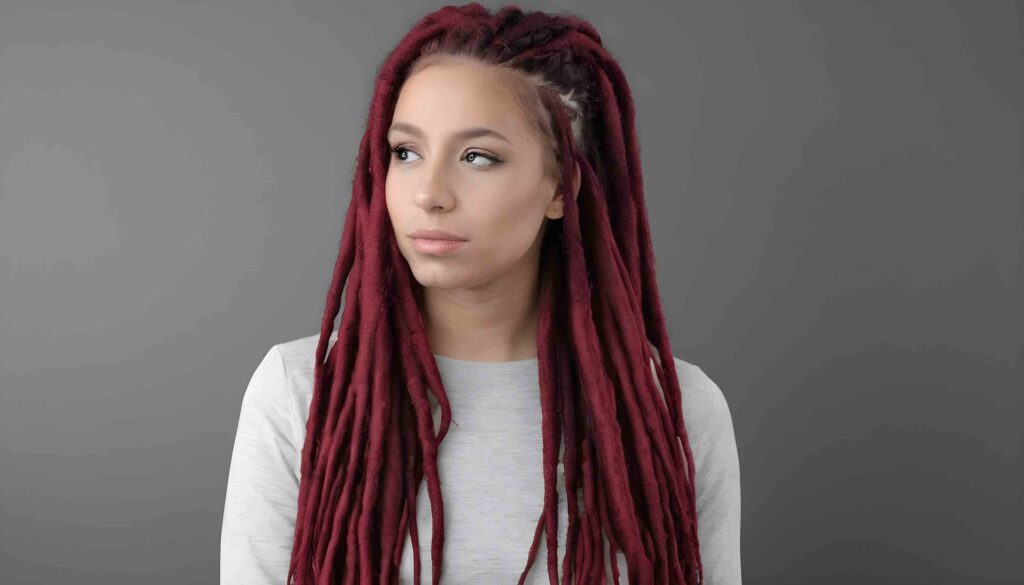
Burgundy offers a rich, elegant hue for dreadlocks. The deep red tone with subtle violet undertones provides a striking yet sophisticated look. When coloring your locs burgundy, choose a semi-permanent dye formulated for textured hair. Prep by clarifying and detangling hair, then section evenly for precise application. Use a tint brush to saturate each loc,
processing the dye fully. Rinse thoroughly until the water runs clear. Deep condition after coloring to nourish locs. To maintain the vibrant burgundy tone, wash dreads less frequently with sulfate-free shampoo and use a leave-in conditioner. Avoid chlorine, sun exposure, and heat styling which can fade the color. With strategic coloring methods and proper care, burgundy color dreads offer an eye-catching style with dimensional, wine-inspired hues.
Coloring Locs 101: Tips for Vibrant Hues and Healthy Hair
Dreadlocks are a versatile canvas for expressing your personal style. While dyeing locs can damage hair, proper techniques ensure you can rock vibrant colors while maintaining healthy locks. Follow this beginner’s guide for achieving picture-perfect dyed locs.
Prepare Locs for Coloring
Prepping your hair ensures the dye takes evenly and minimizes damage. Before coloring:
- Shampoo hair thoroughly to remove dirt and oil
- Do an apple cider vinegar (ACV) rinse to open the cuticles
- Towel dry hair – do not comb or disturb locs
- Moisturize each loc with oil to prevent dryness
- Section hair cleanly for precise application
Choosing a Dreadlock Dye
Pick a high-quality semi-permanent dye formulated for locs and textured hair. Avoid dyes with harsh chemicals like peroxide or ammonia. Look for nourishing ingredients like:
- Aloe vera – Soothes and hydrates hair
- Avocado oil – Conditions and adds shine
- Shea butter – Softens and protects locs
- Cocoa butter – Seals in moisture to prevent drying
- Honey – Improves moisture retention
Vibrant semi-permanent dyes specially designed for locs allow you to safely infuse your hair with long-lasting color.
Application Tips & Tricks
- Section hair: Work in sections of 10-20 locs to easily control application.
- Use a tint brush: Apply dye from roots to tips using a tint brush for full saturation.
- Wear gloves: Use gloves to avoid staining hands and facilitate neat application.
- Work quickly: Have all supplies ready so you can work efficiently from one section to the next.
- Process fully: Leave on for the full recommended development time.
- Rinse thoroughly: Rinse with cool water until the water runs clear.
- Deep condition: Nourish hair with a reparative deep conditioner.
Following these pro application tips allows the dye to take evenly for beautiful, vivid results your locs will love.
Post-Dye Locs Care
- Moisturize daily with leave-in conditioner and oils
- Wash less frequently, using sulfate-free dreadlock shampoo
- Limit heat styling to preserve moisture
- Sleep with a satin cap or pillowcase to minimize friction
- Get regular trims to maintain loc health from roots to tips
- Use color-depositing treatments to refresh color
With the proper prep, application techniques, and aftercare, you can enjoy stunning dyed locs without compromising hair health. Express yourself with color while maintaining strong, hydrated locks.
Achieve Beautiful Locs: The Art of Coloring Without Harm
Dreadlocks offer endless styling possibilities, including experimenting with vivid dyes. However, chemical processing can damage the delicate structure of locs. Learn professional techniques for coloring your locs while keeping your hair healthy and strong.
Prep Hair for Dyeing
Pre-coloring prep protects locs and allows the dye to absorb evenly. One week before coloring, do a clarifying wash with dreadlock shampoo to remove buildup. Follow with an apple cider vinegar (ACV) rinse to open cuticles. After drying, divide hair into sections and coat locs with a nourishing oil.
Choosing the Right Dye
Avoid using conventional permanent hair dyes, which are too harsh for delicate locs. Opt for semi-permanent or demi-permanent dyes designed specifically for locs, free of damaging peroxide or ammonia. Quality brands offer conditioning formulas that won’t dry out your hair.
Master Dye Application
Applying dye properly ensures even saturation without harming locs:
- Wear gloves to keep hands clean
- Work in sections of 10-20 locs for control
- Use a tint brush to apply dye from roots to ends
- Saturate each loc thoroughly for uniform color
- Process for the minimum recommended time
- Rinse thoroughly with cool water
Follow with a reparative deep conditioning treatment to nourish locs.
Maintain Dyed Locs
Preserve your new hue and keep locs healthy with:
- Daily moisturizing oils to boost shine
- Sulfate-free shampoos and silicone-free conditioners
- Limiting washing to 1-2 times per month
- Avoiding heat styling tools
- Sleeping on a satin pillowcase
- Getting regular trims to snip damaged ends
Coloring locs requires meticulous techniques and aftercare to prevent breakage and dryness. With the proper precautions, you can achieve stunning hues and maintain strong, healthy dreadlocks.
Loc Love: How to Dye and Maintain Your Dreadlocks
Dreadlocks let you fully embrace your gorgeous natural texture. Coloring your locs allows you to experiment with different vibes, from subtle ombre highlights to wildly neon shades. Follow these tips for safely dyeing locs while keeping them healthy and hydrated.
Choosing a Dreadlock Dye
Steer clear of permanent dyes with harsh chemicals like peroxide or ammonia, which cause extreme dryness and damage. Opt for semi-permanent or demi-permanent dyes designed specifically for locs and textured hair types. Look for fortifying ingredients like:
- Shea butter – Softens and protects locs
- Aloe vera – Soothes and hydrates
- Avocado oil – Conditions and adds shine
- Honey – Improves moisture retention
High-quality dreadlock dyes allow you to color safely without drying out your hair.
Pre-Dye Prep
Proper prep prevents damage and allows the color to take evenly. One week before dyeing:
- Do an apple cider vinegar rinse to open the cuticles
- Shampoo with residue-removing dreadlock shampoo
- Detangle gently – don’t disturb locs
- Section hair cleanly for precise application
- Seal in moisture with oil to prevent dryness
Dye Application Tips
Follow these pro tips for flawless results:
- Wear gloves to keep the dye off your hands
- Work in sections of 10-20 locs at a time
- Use a tint brush to coat each loc thoroughly
- Process for the minimum recommended time
- Rinse with cool water until water runs clear
- Deep conditions to restore moisture
Post-Dye Loc Care
Keep your color vibrant and locs healthy by:
- Moisturizing daily with leave-in conditioner and oils
- Washing 1-2 times per month with residue-removing shampoo
- Avoiding heat styling tools
- Trimming regularly to prevent split ends
- Using color-depositing treatments to refresh color
- Sleeping on a satin pillowcase to minimize friction
With the right dye and proper technique, you can color your locs with confidence while maintaining healthy, hydrated hair. Express yourself and have fun with color!
The Ultimate Guide to Coloring Locs Safely and Beautifully
Dreadlocks offer an edgy, artistic look that lets your texture take center stage. While dyeing locs allows you to experiment with vibrant colors, improper techniques can cause damage. Follow these professional tips to color your locs while keeping them healthy and strong.
Choosing a Dreadlock Dye
Conventional permanent dyes containing peroxide or ammonia are too harsh for delicate locs. Opt for semi-permanent or demi-permanent dyes made specifically for locs and textured hair types. Quality brands offer conditioning formulas that won’t dry out your hair.
Seeking vivid color that lasts? Demi-permanent dyes offer bolder hues with lower peroxide levels. Semi-permanent dyes provide an ultra-conditioning color that gradually washes out over 4-8 weeks.
Pre-Color Prep
Prepping your hair properly before coloring minimizes damage and allows the dye to take evenly. One week before dyeing:
- Clarify with dreadlock shampoo to remove buildup
- Do an apple cider vinegar rinse to open the cuticles
- Section hair neatly and detangle gently
- Seal in moisture by massaging oil into each loc
Pro tip: Wearing gloves during prep keeps hands stain-free!
Mastering Dye Application
Applying dye to locs requires precision. Follow these techniques for flawless saturation from roots to ends:
- Work in sections of 10-20 locs for control
- Use a tint brush to coat each loc thoroughly
- Process for the minimum recommended time
- Rinse patiently with cool water until clear
- Deep condition to restore moisture after rinsing
Take your time so no loc goes uncoated – your patience will pay off in vibrant, even color!
Post-Dye Care for Healthy Locs
Keep your color vibrant and hydrated by:
- Moisturizing daily with leave-in conditioner and oils
- Washing every 1-2 weeks with residue-removing shampoo
- Avoiding heat styling tools
- Getting regular trims to prevent split ends
- Using color-depositing treatments to maintain your hue
- Sleeping on a satin pillowcase to minimize friction
With the right techniques and aftercare, you can color your locs with confidence while maintaining healthy, hydrated hair. Show off your artistic flair with stunning hues!
Coloring Your Locs: Tips and Tricks for Stunning Results
Dyeing your locs allows you to freshen up your look with vibrant color. But coloring dreadlocks require special care to prevent dryness and damage. Follow these expert tips for achieving eye-catching hues on your locs while keeping them healthy.
Choosing the Right Dye
Steer clear of permanent hair dyes containing harsh chemicals like peroxide or ammonia. These can irreparably damage delicate locs. Instead, opt for a semi-permanent or demi-permanent formula specially designed for locs and textured hair types.
Pre-Color Prep
Prepping your hair properly before coloring is key. One week before dyeing:
- Wash hair with clarifying dreadlock shampoo
- Do an apple cider vinegar rinse to open the cuticles
- Air dry hair then section cleanly
- Massage nourishing oil into each loc
Application Tips & Tricks
- Work in sections of 10-20 locs at a time
- Use a tint brush to coat each loc from root to tip
- Wear gloves to keep hands stain-free
- Process for the minimum recommended time
- Rinse thoroughly until water runs clear
- Deep conditions to restore moisture
Post-Color Loc Care
Keep your new color vibrant and locs healthy by:
- Moisturizing daily with leave-in conditioner and oils
- Washing every 7-14 days with residue-removing shampoo
- Avoiding heat styling tools
- Getting regular trims to snip damaged ends
- Using color-depositing treatments to maintain color
- Sleeping on a satin pillowcase to prevent friction
With the proper techniques and aftercare, you can achieve stunning color results on your locs while maintaining their health and integrity.
Loc Care Essentials: Coloring Your Hair with Confidence
Dreadlocks offer endless styling possibilities, including experimenting with eye-catching hues. But coloring locs requires a gentle approach to prevent dryness and damage. Follow these pro tips to dye your locs with confidence while keeping your hair healthy.
Choosing the Ideal Dye
Steer clear of permanent dyes containing harsh peroxide or ammonia, which cause extreme dryness and breakage in delicate locs. Opt for semi-permanent or demi-permanent dyes designed specifically for locs and textured hair types. Quality brands offer conditioning formulas that won’t compromise your locs.
Pre-Color Prep
Properly prepping your hair before coloring minimizes damage and allows the dye to absorb evenly. One week before coloring:
- Wash hair with clarifying dreadlock shampoo
- Do an apple cider vinegar rinse to open the cuticles
- Pat dry hair and section neatly
- Massage oil into each loc to prevent dryness
Mastering Dye Application
Applying dye properly ensures every loc gets coated evenly for flawless results:
- Work in sections of 10-20 locs at a time
- Use a tint brush to coat each loc thoroughly
- Process for the minimum recommended time
- Rinse patiently until water runs clear
- Deep conditions to restore moisture
Take your time – good technique prevents uneven color or missed spots.
Post-Color Care
Keep your new color vibrant and locs healthy by:
- Daily moisturizing with leave-in conditioner and oils
- Washing every 7-14 days with residue-removing shampoo
- Avoiding heat tools that cause dryness
- Getting regular trims to snip damaged ends
- Using color-depositing treatments to maintain color
- Sleeping on a satin pillowcase to prevent friction
With proper precautions and aftercare, you can color your locs while keeping them healthy, hydrated, and fabulous!
Unlocking the Secrets to Healthy, Vibrant Locs: A Coloring Guide
Dreadlocks let you fully embrace your gloriously textured hair. While coloring locs allows you to experiment with different hues, many conventional dyes can wreak havoc on your hair health. Learn professional techniques for safely dyeing locs while achieving vibrant, stunning color.
Choosing the Right Dye
Avoid permanent dyes with harsh chemicals like peroxide or ammonia. These aggressively strip color from the hair, causing extreme dryness and breakage in delicate locs.
Instead, opt for semi-permanent or demi-permanent dyes designed specifically for locs and textured hair. Quality dreadlock dye brands offer gentler, conditioning formulas that won’t compromise your hair.
Prep for Dyeing Success
Properly prepping your hair before coloring is crucial to prevent damage and ensure the dye absorbs evenly.
One week before coloring:
- Clarify hair with dreadlock shampoo to remove residue
- Do an apple cider vinegar rinse to open the cuticles
- Pat dry hair and neatly section it for precise application
- Massage hair with nourishing oils to prevent dryness
Mastering Dye Application
Applying dye properly guarantees flawless saturation from root to tip:
- Work in sections of 10-20 locs at a time
- Use a tint brush to thoroughly coat each loc
- Process for the minimum recommended time
- Rinse patiently until water runs completely clear
- Deep condition to restore moisture after rinsing
Take your time and don’t rush the rinsing stage – quality application leads to vibrant results.
Post-Color Care for Locs
Keep your color vibrant and locs healthy by:
- Daily moisturizing with leave-in conditioner and oils
- Washing every 7-14 days with residue-removing
- Avoiding heat tools that cause dryness
- Getting regular trims to snip damaged ends
- Using color-depositing treatments to maintain color
- Sleeping on a satin pillowcase to prevent friction
With the proper dye selection, preparation, application, and maintenance, you can color your locs with confidence while keeping them healthy, strong, and fabulous!
Coloring Dreadlocks: Expert Tips for Stunning, Damage-Free Results
Dreadlocks offer endless styling possibilities, including experimenting with vibrant dyes. However, many conventional hair colors contain damaging ingredients like peroxide and ammonia that can severely compromise the health of your locs. Follow these professional techniques for safely coloring your locs while achieving striking results.
Choosing a Gentle, Nourishing Dye
Steer clear of permanent dyes with harsh chemicals that cause extreme dryness and breakage in delicate locs. Instead, opt for a semi-permanent or demi-permanent formula specially created for locs and textured hair types. Look for fortifying ingredients like:
- Avocado oil – Conditions and adds shine
- Shea butter – Softens and protects locs
- Aloe vera – Soothes and hydrates hair
- Honey – Improves moisture retention
Quality dreadlock dyes color hair without stripping, drying, or damaging.
Pre-Color Prep
Properly preparing your locs before coloring allows the dye to absorb evenly and prevents damage. One week before applying color:
- Wash with clarifying dreadlock shampoo
- Do an apple cider vinegar rinse to open the cuticles
- Pat dry, then section hair neatly for dyeing
- Massage locs with nourishing oils to prevent dryness
Mastering Dye Application
Applying dye properly guarantees flawless, uniform color from roots to tips:
- Work in sections of 10-20 locs at a time
- Use a tint brush to coat each loc thoroughly
- Process for the minimum recommended time
- Rinse patiently with cool water until running clear
- Deep conditions to restore moisture
Take your time and don’t rush – patience ensures perfect results!
Post-dye care for Vibrant, Healthy Hair
Maintain your eye-catching color and keep locs hydrated by:
- Daily moisturizing with leave-in conditioner and oils
- Washing every 7-14 days with residue-removing shampoo
- Avoiding heat styling that causes dryness
- Getting regular trims to snip damaged ends
- Using color-depositing treatments to refresh color
- Sleeping on a satin pillowcase to prevent friction
With the right techniques and aftercare, you can achieve stunning hues on your locs without any damage! Show off your colorful style.
Locs of Love: How to Color Your Hair Safely and Maintain Healthy Locs
Dreadlocks let you fully embrace your natural coils and curls. Coloring your locs allows you to experiment with different shades, from subtle highlights to vibrant neon hues. But coloring requires special care to prevent dryness and damage in delicate locs. Here are pro tips to help you dye your locs safely while keeping them healthy.
Choosing a Gentle, Nourishing Dye
Stay away from permanent dyes with aggressive chemicals like peroxide and ammonia, which cause extreme drying and breakage in locs. Instead, choose a semi-permanent or demi-permanent formula designed specifically for textured hair types. Look for hydrating ingredients like:
- Aloe vera to soothe and moisturize hair
- Avocado oil to condition and add shine
- Shea butter to soften and protect locs
Quality dreadlock dyes color safely without stripping or drying.
Prepping Hair Before Coloring
Properly preparing your locs before dyeing helps the color absorb evenly and prevents damage. One week before coloring:
- Wash hair with clarifying dreadlock shampoo
- Do an apple cider vinegar rinse to open the cuticles
- Pat dry, then neatly section hair for dyeing
- Massage locs with oil to prevent dryness
Dyeing Locs Like a Pro
Apply dye precisely from roots to tips for flawless saturation:
- Work in sections of 10-20 locs at a time
- Use a tint brush to coat each loc thoroughly
- Process for the minimum recommended time
- Rinse patiently until water runs completely clear
- Deep conditions to restore moisture
Take your time – don’t rush the rinsing stage.
Post-Color Care for Luscious Locs
Keep your new hue vibrant and hydrated by:
- Daily moisturizing with leave-in conditioner and oils
- Washing weekly with residue-removing shampoo
- Avoiding heat tools that cause dryness
- Getting regular trims to snip damaged ends
- Using color-depositing treatments to refresh color
- Sleeping on a satin pillowcase to prevent friction
With proper techniques and care, you can color your locs beautifully while keeping them healthy, strong, and fabulous!
How to Color Locks Without Damage: Guide to Dyeing Locs | Madison Reed
Dreadlocks offer an edgy, artistic hairstyle that lets your glorious texture take center stage. Coloring your locs allows you to experiment with different vibrant shades. However, many conventional hair dyes can damage the delicate structure of locs. Follow these pro tips for dyeing your locks safely without causing dryness or breakage.
Choose a Gentle, Nourishing Dye
Avoid permanent dyes with harsh chemicals like peroxide and ammonia, which strip color aggressively and cause extreme dryness in locs. Instead, opt for a semi-permanent or demi-permanent formula designed specifically for textured hair types. Look for hydrating ingredients like:
- Aloe vera to soothe and moisturize hair
- Avocado oil to condition and add shine
- Shea butter to soften and protect locs
Quality dreadlock dyes color safely without drying.
Prep Hair Before Dyeing
Properly preparing your locs before coloring helps the dye absorb evenly and prevents damage. One week before coloring:
- Wash with clarifying dreadlock shampoo
- Do an apple cider vinegar (ACV) rinse to open the cuticles
- Pat dry hair and neatly section for coloring
- Massage locs with oil to prevent dryness
Master Dye Application
Apply dye precisely from roots to tips for flawless, uniform color:
- Work in sections of 10-20 locs at a time
- Use a tint brush to thoroughly coat each loc
- Process for the minimum recommended time
- Rinse patiently until water runs completely clear
- Deep conditions to restore moisture
Take your time – don’t rush through the rinsing phase.
Post-Dye Care for Healthy Locs
Maintain your new hue and keep locs hydrated by:
- Daily moisturizing with leave-in conditioner and oils
- Washing weekly with residue-removing shampoo
- Avoiding heat tools that cause dryness
- Getting regular trims to snip damaged ends
- Using color-depositing treatments to refresh color
- Sleeping on a satin pillowcase to prevent friction
With the proper techniques and aftercare, you can dye your locs vibrantly without any damage!
Part Your Locs into 4 Sections
One key technique for minimizing damage when dyeing dreadlocks is to neatly section the hair first. This allows you to easily access, saturate, and rinse each loc thoroughly.
Follow these steps for perfectly parted locs:
- Start with freshly washed, detangled hair. Do not disturb locs.
- Create a clean center part from the forehead to the nape. Use the natural parting space or carefully partition with a tail comb.
- Create another part that runs horizontally from ear to ear.
- Clip up the other sections so you are only working with one section at a time.
- When dyeing, saturate the roots thoroughly first, then work the dye through to the very tips using a tint brush.
- After rinsing, repeat with each section.
Parting your locs cleanly before dyeing minimizes overlapping and ensures every loc gets uniformly coated for even, vivid color from roots to ends. Precise sectioning prevents missed spots or uneven dye absorption.
Apply Barrier Cream and the Color
When dyeing dreadlocks, using a barrier cream around the hairline and on the scalp prevents skin staining. Follow these steps for neat, mess-free color application:
Prep
- Wash and section hair, detangling gently without disturbing locs
- Use a Q-tip to apply petroleum jelly thoroughly along the hairline
Dye Application
- With gloved hands, massage barrier cream onto the scalp and along the hairline
- Apply dye starting 1/2 inch away from the roots to avoid staining the scalp
- Saturate each loc thoroughly from roots to ends using a tint brush
- Use a cotton swab dipped in dye to precisely coat locs near the hairline
- Clip hair up and allow to process fully
Cleanup
- Rinse dye until water runs clear; use cool water
- Shampoo scalp and hairline well to remove barrier product
- Apply restorative hair mask and let sit 5 minutes before rinsing
- Style locs as desired
Barrier cream prevents dye from staining skin but still allows your entire loc length to absorb color evenly. Take your time applying for flawless results!
Apply a Cap and Wait
Letting the dye process fully on your locs is essential for achieving vibrant, lasting color. Follow these pro tips for the processing stage:
- After saturating each loc with dye from roots to ends, put on a plastic cap to retain moisture and heat.
- Wrap hair in a warm, moist towel and let sit undisturbed for the full processing time.
- Check regularly to ensure the cap stays secure – tighten if needed.
- Avoid using heat during this stage, as too much warmth can overprocess delicate locs.
- Set a timer and wait out the full recommended development time to allow the color to absorb fully.
- For semi-permanent dyes, 15-20 minutes is ideal. For demi-permanent, process up to 30 minutes.
- Use water-resistant shower caps during future showers to make the color last as long as possible.
Good things come to those who wait! Give the dye time to penetrate for maximum vibrancy. Then reveal your gorgeous hue.
Wash Out the Hair Color
Once the dye has processed fully on your locs, the next step is thoroughly rinsing it out. Follow these tips for clean, color-free results:
- Rinse with cool to lukewarm water to preserve your vibrancy
- Initially focus the stream at your roots to wash out excess dye there
- Gently massage locs to help water penetrate inside and flush out the color
- Loc by loc, ensure every strand runs clear before moving on
- Split locs apart to check for hidden excess dye deeper inside
- Rinse patiently until all locs, even underneath, are completely color-free
- Repeat shampooing if needed to remove all traces of leftover dye
- When locs no longer bleed color, conditioning can begin
Take your time rinsing – lingering dye can transfer onto clothes and sheets. inspection and patience prevent unwanted stains after dyeing.
Retwist Your Locs to Style
Once your vivid new color is thoroughly rinsed out and in hair condition, the final step is styling your freshly dyed locks. Here are tips for flawless retwisting:
- Work in sections for control and use clips to separate finished locs.
- Ensure hair is detangled and moisturized before twisting.
- Hold each loc taut and use an overhand motion with your wrist to gently roll and twist up.
- Use locking gel or wax to help smooth and set twisted locs.
- Twist clockwise from roots to ends, rolling hair tight but not too tight.
- Twist new growth at roots for a uniform, neat look all over.
- Sit under a hooded dryer to completely set twisted locs in place.
- Finish with holding spray for extra hold and sheen.
Retwisting after dyeing trains locs to stay separated as your color oxidizes. Newly dyed hair may bleed a bit – avoid light fabrics at first.
Conclusion
In conclusion, coloring dreadlocks allows you to showcase vibrant hues and unique styles while expressing your individuality. However, great care must be taken when dyeing locs to avoid damaging delicate hair. Using professional techniques is key.
Choose semi-permanent dyes without harsh chemicals like peroxide or ammonia to prevent drying and breakage. Properly section and detangle hair beforehand and apply dye meticulously from root to tip. Let color process fully, then rinse extremely thoroughly until all traces disappear. Finish by moisturizing and retwisting hair.
With the proper preparation, application, and aftercare, you can achieve stunning dyed locs without compromising your hair’s health. Nourish and protect your locks while experimenting with eye-catching colors.
Frequently Asked Questions Color Dreads
What is the best color for dreads?
Natural tones and vibrant shades tend to show up best and last longest on dreadlocks. Warm hues like golden blonde, copper, and burgundy give a natural yet striking look. Bold colors like electric blue, neon pink, and purple make a vibrant statement. Pastels can work with pre-lightened hair. Avoid black, as it’s challenging to achieve on locs.
Can you color dreadlocks?
Yes, you can safely color dreadlocks using the proper techniques and dyes formulated for textured hair. Avoid conventional permanent dyes with damaging ingredients like peroxide and ammonia. Opt for semi-permanent or demi-permanent dreadlock dyes to prevent dryness and breakage.
What’s the difference between dreads and locs?
Dreadlocks and locs essentially refer to the same style – hair that is allowed to naturally mat and form into rope-like strands. However, some prefer the term “locs” as it doesn’t carry an outdated stereotype. Both names describe textured hair that tangles and coils to form freeform twisted strands.
What are the three types of locs?
The three main types of dreadlock or loc methods are:
- Freeform: Locs form naturally without manipulation
- Salon-groomed: Hand-twisted or palm rolled by a loctician
- Self-made: Waxed and twisted at home into sections
Which is better locs or dreads?
There is no clear “better” option between locs and dreads – it comes down to personal preference! Both can be started and maintained in various ways. The terms refer to the same overall look. Consider your lifestyle and desired appearance to decide which method is right for you.
What are girl dreads called?
While dreadlocks on women are sometimes referred to as “locs” to avoid stereotypes, there is no separate name specifically for “girl dreads.” Feminine descriptives like goddess loc or Bohemian locs are sometimes used. But dreadlocks and locs can describe the hairstyle of any gender.
How long do dreads last?
With proper care and maintenance, dreadlocks can potentially last for years or even decades. However, factors like your hair type, styling method, and lifestyle impact longevity. Tightly coiled hair may lock up faster than loose curls. Crochet and twist methods may last longer than freeform.
Is 40 dreads enough?
There is no “ideal” number of locs – 40 can be enough, but it depends on your head size and desired look. Small, thin locs show scalp and look more abundant while larger locs provide a fuller appearance. For average density on medium hair, 50-100 locs often work well. But customize your number based on personal preference.
Is it safe to dye dreads?
You can safely dye dreadlocks using the proper techniques. Avoid conventional permanent dyes with damaging chemicals. Opt for semi-permanent dreadlock dyes without peroxide or ammonia. Prep hair properly, apply dye carefully, rinse thoroughly, and maintain moisture. Take precautions to color dreads without damage.
Which dye is best for dreadlocks?
Look for semi-permanent or demi-permanent dyes specifically formulated for locs and textured hair when coloring dreadlocks. Quality brands like Dreadlocks Dyes, Taliah Waajid, Design Essentials, and more offer non-damaging dreadlock dye options. Avoid permanent dyes with harsh chemicals like peroxide or ammonia.
Is 50 locs enough?
50 locs is generally a good starting number for medium to thick hair. It allows for a balanced density, where locs are not too thin and the scalp doesn’t show too much. However, hair thickness and personal preference should determine the number. Thinner hair may suit more locs while thick hair works with fewer. Customize the amount based on your goals.
What is the best color for dreadlocks?
Vibrant shades and natural tones tend to show up best and last longest on locs. Beautiful options include warm hues like honey blonde, copper, and burgundy, or bold colors like electric blue, hot pink, and purple. Black can be challenging. Pastels work for pre-lightened hair. Consider your complexion when choosing a dreadlock color.
What color hair is copper?
Copper hair is a shiny mix of red and brown that mimics the burnished glow of a copper penny. It ranges from lighter strawberry and orange tones to deeper auburn hues. This multi-dimensional natural-looking color flatters a wide variety of skin tones.
What color does copper hair fade to?
Copper hair tends to fade progressively lighter and warmer over time. The vibrant shade slowly fades towards a strawberry blonde or orangey light brown. To counteract fading, use color-depositing products and avoid washing too frequently. Get regular glossing treatments to maintain the signature copper shine.
What color is copper red?
Copper red hair is a metallic blend of rich auburn and orangey red tones. It has an intense, electrifying effect. This fiery hue looks especially striking on those with cool, lighter complexions. The shimmery color straddles both warm and cool
What is a good color to dye dreads?
Some great colors to dye dreadlocks include:
- Natural tones like golden blonde, chocolate brown, auburn
- Vibrant shades like electric blue, hot pink, purple
- Pastels for pre-lightened hair like lavender, peach, mint
- Ombre blends from dark roots to light ends
- Two-tone with contrasting colors on top/bottom
- Metallic shades like copper, silver, rose gold
Avoid black dye, which can be challenging on locs. Consider your complexion when choosing colors.
What are black locs?
Black locs refer to dreadlocks or braided locs that are dyed or naturally jet-black in color. This striking hue provides an ultra-sleek, glossy appearance. However, achieving a rich solid black on dreadlocks can be challenging and requires perfect application. Dark hues like chocolate brown are easier.
Maintaining black locs demands vigilant upkeep as any roots or new growth is highly noticeable. Using semi-permanent black dye is better than permanent to avoid excessive drying and damage on delicate locs. Take special care to keep black locs looking their absolute sharpest.
How do I choose the right color for my dreadlocks?
Consider the following factors when choosing the right dreadlock color:
- Your skin tone and undertones
- Your current base color
- The look you’re trying to achieve (subtle/natural or bold/vibrant)
- How much maintenance you’re willing to do
- If you’ll be lightening or darkening your locks
- How quickly your natural color tends to fade
- How healthy your hair currently is
Doing a strand test can also help you preview potential colors before fully committing.
What’s the easiest dreadlock color to maintain?
Natural-looking shades tend to be the easiest dreadlock colors to maintain as regrowth is far less noticeable. Warmer tones like light to medium browns, soft blondes, and auburn/copper hues blend seamlessly into new growth. Avoid high-maintenance black or pastel hues unless you plan to frequently retouch roots.
How often should I redye my dreadlocks?
How often you should re-dye dreadlocks depends on factors like your hair type, color choice, and desired vibrancy. Permanent dyes may last 4-6 weeks. Semi-permanent dyes fade more gradually over 6-8 weeks. Target re-dyeing about 1-2 weeks before your color begins to noticeably fade for fresh results. Avoid over-processing the hair.
What’s the best way to dye the roots of dreadlocks?
Apply dye just to the roots using the following techniques:
- Use a pointed tint brush for precise application
- Section locs first for easy access to roots
- Wear gloves and apply barrier cream to avoid skin stains
- Saturate roots thoroughly, keeping dye off previously dyed lengths
- Process just 5-10 minutes since heat focuses on roots
- Rinse extremely thoroughly to remove all excess dye
Focusing just on roots prevents overprocessing previously colored lengths.
Retouch just the regrowth to maintain your gorgeous hue! With proper techniques, you can refresh your dreadlock color as needed without damage.

